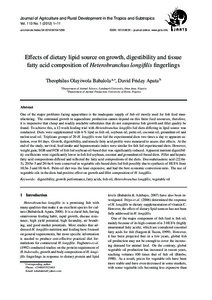| dc.date.accessioned | 2012-09-24T10:57:56Z | |
| dc.date.available | 2012-09-24T10:57:56Z | |
| dc.date.issued | 2012 | |
| dc.identifier.issn | 1612-9830 | |
| dc.identifier.uri | urn:nbn:de:hebis:34-2012061541299 | |
| dc.identifier.uri | http://hdl.handle.net/123456789/2012061541299 | |
| dc.language.iso | eng | |
| dc.publisher | Kassel University Press | ger |
| dc.rights | Urheberrechtlich geschützt | |
| dc.rights.uri | https://rightsstatements.org/page/InC/1.0/ | |
| dc.subject | digestibility | eng |
| dc.subject | growth performance | eng |
| dc.subject | fatty acids | eng |
| dc.subject | fish oil | eng |
| dc.subject | Heterobranchus longifilis | eng |
| dc.subject | vegetable oil | eng |
| dc.subject.ddc | 630 | |
| dc.title | Effects of dietary lipid source on growth, digestibility and tissue fatty acid composition of Heterobranchus longifilis fingerlings | eng |
| dc.type | Aufsatz | |
| dcterms.abstract | One of the major problems facing aquaculture is the inadequate supply of fish oil mostly used for fish feed manufacturing. The continued growth in aquaculture production cannot depend on this finite feed resources, therefore, it is imperative that cheap and readily available substitutes that do not compromise fish growth and fillet quality be found. To achieve this, a 12-week feeding trial with Heterobranchus longifilis fed diets differing in lipid source was conducted. Diets were supplemented with 6% lipid as fish oil, soybean oil, palm oil, coconut oil, groundnut oil and melon seed oil. Triplicate groups of 20 H. longifilis were fed the experimental diets two times a day to apparent satiation, over 84 days. Growth, digestibility, and muscle fatty acid profile were measured to assess diet effects. At the end of the study, survival, feed intake and hepatosomatic index were similar for fish fed experimental diets. However, weight gain, SGR and FCR of fish fed soybean oil-based diet was significantly reduced. Apparent nutrient digestibility coefficients were significantly lower in fish fed soybean, coconut and groundnut oil-based diets. Fillet and hepatic fatty acid compositions differed and reflected the fatty acid compositions of the diets. Docosahexaenoic acid (22:6n-3), 20:5n-3 and 20:4n-6 were conserved in vegetable oils-based diets fed fish possibly due to synthesis of HUFA from 18:3n-3 and 18:4n-6. Palm oil diet was the least expensive, and had the best economic conversion ratio. The use of vegetable oils in the diets had positive effect on growth and fillet composition of H. longifilis. | eng |
| dcterms.accessRights | open access | |
| dcterms.bibliographicCitation | In: Journal of Agriculture and Rural Development in the Tropics and Subtropics. Kassel : Kassel University Press. - Vol. 113, No. 1 (2012), S. 1-11 | |
| dcterms.creator | Babalola, Theophilus Olayiwola | |
| dcterms.creator | Apata, David Friday | |
| dc.description.everything | Gedruckte Ausg. im Verlag Kassel Univ. Press (www.upress.uni-kassel.de) erschienen. | ger |

